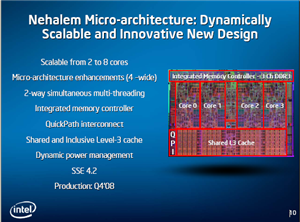Intel moving to six-cores this year; What will you do with them?

Intel outlined plans to produce six-core chips in the fourth quarter. The move is that latest salvo in a game to out-core AMD on everything. AMD finally gets its quad-core chip out the door and Intel moves to six. The future looks like this: Four cores, six cores, eight cores, 10 cores, 12 cores. Oh my. Who wouldn't want all those cores?

Simply put, the core wars just don't bring that much to the table right now in terms of killer apps--unless you count virtualization as the thing that will get the masses enthusiastic. Intel's server chip roadmap assault is really about running circles around AMD, tick tocking to new cores, and most of all preserving if not improving the average selling price of chips. All you have to do is buy more cores and figure out what they'll enable later. Intel needs more cores to thump AMD. You may not need them.
This economic prism on the core wars gets a little annoying because it really puts the kibosh on great headlines. Consider the following:
Intel says:
Intel's current 7300 chipset based platform combined with the Quad-Core Xeon 7300 processor is the industry's virtualization platform of choice for MP servers. Dunnington is socket-compatible with the Caneland platform and will be available in the second half of 2008. Dunnington is the first IA (Intel Architecture) processor with 6-cores, is based on the 45nm high-k process technology, and has large shared caches. Another supported feature is FlexMigration technology, which allows a single compatible virtualization pool that supports live VM (Virtual Machine) migration across both 65nm and 45nm high-k Intel Core microarchitecture-based servers and 45nm-based servers. This provides investment protection as well as the option to choose the right server platform to best optimize performance, cost, power and reliability.
In English: Intel is moving to six cores to make AMD's Barcelona irrelevant. On deck: The price squeeze.
Intel says:
Tukwila is Intel's next-generation Itanium processor with four cores, 30MB total cache, QuickPath Interconnect, dual Integrated Memory Controller and mainframe-class RAS features. It is the world's first 2 billion transistor microprocessor and is projected to deliver more than double the performance of the current generation Itanium processor.
In English: You can figure out what to do with this performance later. Tukwila sounds pretty damn good eh?
Intel says:
Nehalem will provide dramatic performance and energy improvements to Intel's current industry-leading microprocessors. Nehalem is scalable with future versions having anywhere from 2 to 8 cores, with Simultaneous Multi-threading, resulting in 4 to 16 thread capability. Nehalem will deliver 4 times the memory bandwidth compared to today's highest-performance Intel Xeon processor-based systems. With up to 8 MB level-3 cache, 731 million transistors, Quickpath interconnects (up to 25.6GB per second), integrated memory controller and optional integrated graphics, Nehalem will eventually scale from notebooks to high-performance servers. Other features discussed include support for DDR3-800, 1066, and 1333 memory, SSE4.2 instructions, 32KB instruction cache, 32KB Data Cache, 256K L2 data and instruction low-latency cache per core and new 2-level TLB (Translation Lookaside Buffer) hierarchy. These technical improvements will result in performance improvements as well as flexibility for a wide range of eventual products based on the Nehalem architecture. Gelsinger also discussed the new Tylersburg platform, which can be configured for both one socket High End Desktop (HEDT) and two socket (HPC and dual processing server) operation.
In English: Intel is trying to make you drool. One issue: None of us have seen the power of multi-threading in a software application we use every day. There's no "I gotta have it" moment. Maybe Microsoft will figure something out, but by most accounts the company is just starting to get its head around multi-threaded apps. In the meantime, running Office faster isn't much of a sales pitch.
Bottom line: Next time you get lured by multiple cores, think about Intel's average selling prices. In the end, that's what the core wars are about. UBS analyst Uche Orji is no dummy. In a research note, Orji isn't drooling over six cores, eight cores or any other multiple other than Intel's stock price.
Orji writes:
As Intel's tick-tock execution strategy is based on building upon its prior generations, its upcoming Nehalem architecture builds on its current performance leading Core family. Most important with Nehalem is our belief that Intel will be able to raise average selling prices on its server processors by 9% in 2009 (vs flat in '08) based on a ~ 50% performance increase. Adding the secular trends to faster speed grades & lower power could result in ASP upside.
That riff roughly translates into more performance at a slightly higher price. It's up to you to figure out what exactly you'll do with more power.